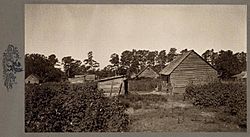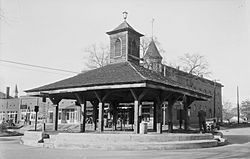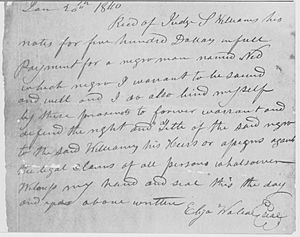Treatment of slaves in the United States facts for kids
In the United States, people who were enslaved faced very harsh conditions. They were often treated badly, not allowed to learn to read or write, and punished with whippings. Families were frequently torn apart when members were sold, often never seeing each other again.
Contents
Why Some People Defended Slavery
Before the American Civil War, some people who supported slavery claimed it was good for everyone, including the enslaved people themselves. They said it was a kind system that helped society and the economy. They even argued it was part of a divine plan, better than the free labor system in the North.
However, this was not true. An African-American abolitionist named J. Sella Martin explained that any "contentment" shown by enslaved people was just a way to cope with the terrible pain of seeing their loved ones sold.
After the Civil War and the end of slavery, some people in the South created a false story called the Lost Cause. This story tried to justify White supremacy and segregation. It wrongly claimed that enslaved people were happy and loyal. In reality, enslaved people desperately wanted to be free. During the Civil War, 180,000 African-American soldiers fought for the United States Army, but no enslaved person fought as a soldier for the Confederacy.
Rules for Enslaved People
The rules that controlled enslaved people were called slave codes. In new states and territories, powerful plantation owners created these laws. Their goal was to make sure slavery stayed strong and safe in their regions.
For example, in North Carolina, slave codes said that enslaved people should be clothed and fed. Killing an enslaved person was punishable. However, enslaved people could not speak against white people in court. They also could not start any legal actions.
Daily Life and Conditions
Historian Kenneth M. Stampp studied many old records to understand how slave owners tried to create an "ideal slave." Here are some of the things they tried to do:
- Keep very strict control and demand complete obedience.
- Make enslaved people feel like they were not important, so they would "know their place."
- Make them afraid to disobey.
- Try to make them care about their owner's business.
- Stop them from getting an education or having fun. This was to keep them uneducated, helpless, and dependent.
Education and Information Access
Slave owners were very scared of slave rebellions. They tried to limit what enslaved people knew about the outside world. This was to stop them from dreaming of freedom or learning about escaped slaves and rebellions. They also wanted to stop them from thinking too much.
Teaching enslaved people to read was often discouraged or even against the law. Owners believed that educated enslaved people would become sad, disrespectful, or "uppity." They might learn about the Underground Railroad, a secret network that helped enslaved people escape. They might also learn that many people would help them, and that there were large communities of formerly enslaved Black people in Northern cities.
After rebellions like the Haitian Revolution and the Nat Turner's slave rebellion in 1831, some states made it illegal for enslaved people to gather for religious meetings or any other reason without a white person present. This was because owners feared these meetings could lead to communication and plans for rebellion or escape.
In 1841, Virginia punished those who broke this law. An enslaved person caught learning could get 20 lashes. The teacher could be fined $100. In North Carolina, the punishment was 39 lashes for the enslaved person and a $250 fine for the teacher. In Kentucky, educating enslaved people was legal but rarely happened. Some slaveholders in Missouri did educate their enslaved people or allowed them to learn on their own.
Health Care for Enslaved People
The quality of medical care for enslaved people was often poor. While some historians suggest owners provided good care to protect their "investment," many agree that care was generally bad. Owners and doctors often tried to get as much work as possible from enslaved people without causing death or serious injury.
A system of medical care existed where enslaved people received worse treatment than white people. They were also kept out of formal medical training. This meant enslaved people were mostly responsible for their own health.
Care was usually given by other enslaved people or by the slaveholders and their families. Doctors were rarely called. Women often cared for sick household members. Some enslaved people had medical skills, like knowing about herbal remedies and midwifery. They often treated both enslaved and non-enslaved people. Enslaved people often relied on African remedies, adapting them to plants found in North America. They also used folk healers, grandmother midwives, and community groups like churches for support.
Families Torn Apart
Elizabeth Keckley, who was enslaved in Virginia, later became a dressmaker for Mary Todd Lincoln. She shared a sad story about a boy named Little Joe. He was the cook's son and was sold to pay his owner's debts.
Elizabeth described how Joe's mother was told to dress him in his best clothes. He was then sold "like the hogs, at so much per pound." His mother begged for him not to be taken, but her master lied, saying Joe would be back the next morning. Joe never returned. His mother went to her grave without ever seeing her child again. She was even whipped for being sad about losing her son. Owners did not like to see their enslaved people look sorrowful.
Between 1790 and 1860, about one million enslaved people were forced to move from the Atlantic coast states to the interior of the country. This terrible journey was called the Second Middle Passage. It almost always meant that children were separated from their parents, and husbands from their wives.
Forced Reproduction
Some slave owners tried to control the reproduction of their enslaved people to make more money. This included forcing male and female enslaved people to have children. They encouraged pregnancies to increase the number of enslaved people they owned.
For example, Frederick Douglass, who was enslaved in Maryland, wrote about how families were systematically broken up. As cotton farms grew in the Deep South, owners in the Upper South often separated families. They sold "extra" male enslaved people to other markets.
Children of Mixed Race
By the early 1800s, many mixed-race families existed in Virginia. White women, often indentured servants, had relationships with enslaved or free African-descended men. Because the mother's status determined the child's status, these children were born free. They often married other free people of color.
Over time, more and more enslaved people in the United States were of mixed race. The 1850 census showed 245,000 enslaved people were mixed-race. By 1860, this number grew to 411,000 out of a total of 3.9 million enslaved people.
A well-known example is the children of Sally Hemings. Many historians now believe her children were fathered by Thomas Jefferson. This change in understanding is shown in exhibits at Monticello, Jefferson's home.
Some historians believe that one reason George Washington freed his enslaved people in his will was because they included two half-sisters of his wife, Martha Custis. These mixed-race enslaved people were born to enslaved women owned by Martha's father. They were thought to be his children. Washington owned Martha Custis's enslaved people after they married. He faced a difficult situation owning his wife's sisters.
Sometimes, plantation owners with mixed-race children arranged for their education, even in northern schools. Others helped them learn skilled trades. Some owners gave them property or freed them and their mothers. While fewer in number than in the Upper South, free Black people in the Deep South were often mixed-race children of wealthy planters. They sometimes received property and social advantages. Wilberforce University, founded in Ohio in 1856, was for African-American youth. In its early years, wealthy Southern planters often paid for the education of their mixed-race children there. When the American Civil War began, most of the school's 200 students were mixed-race children from these wealthy Southern families.
Stories from Survivors of Slavery
Historian Ty Seidule uses a quote from Frederick Douglass's autobiography, My Bondage and My Freedom. Douglass described the life of an average enslaved man as being "robbed of wife, of children, of his hard earnings, of home, of friends, of society, of knowledge, and of all that makes his life desirable."
A powerful quote from a letter by Isabella Gibbons, who was enslaved by professors at the University of Virginia, is now carved on the university's Memorial to Enslaved Laborers:
Can we forget the crack of the whip, the cowhide, whipping-post, the auction-block, the spaniels, the iron collar, the negro-trader tearing the young child from its mother’s breast as a whelp from the lioness? Have we forgotten that by those horrible cruelties, hundreds of our race have been killed? No, we have not, nor ever will.





